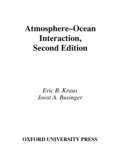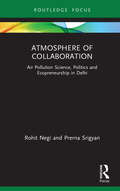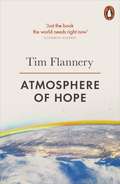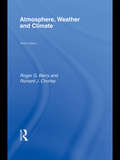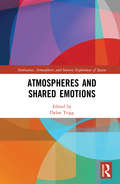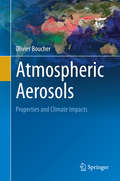- Table View
- List View
Atmosphere, Clouds, and Climate (PDF)
by David RandallThe atmosphere is critical to climate change. It can amplify shifts in the climate system, and also mitigate them. This primer offers a short, reader-friendly introduction to these atmospheric processes and how they work, written by a leading expert on the subject. Giving readers an overview of key atmospheric processes, David Randall looks at how our climate system receives energy from the sun and sheds it by emitting infrared radiation back into space. The atmosphere regulates these radiative energy flows and transports energy through weather systems such as thunderstorms, monsoons, hurricanes, and winter storms. Randall explains how these processes work, and also how precipitation, cloud formation, and other phase changes of water strongly influence weather and climate. He discusses how atmospheric feedbacks affect climate change, how the large-scale atmospheric circulation works, how predicting the weather and the climate are fundamentally different challenges, and much more. This is the ideal introduction for students and nonspecialists. No prior experience in atmospheric science is needed, only basic college physics. Authoritative and concise, Atmosphere, Clouds, and Climate features a glossary of terms, suggestions for further reading, and easy-to-follow explanations of a few key equations. This accessible primer is the essential introduction to atmospheric processes and the vital role they play in our climate system.
Atmosphere in Urban Design: A Workplace Ethnography of an Architecture Practice (Ambiances, Atmospheres and Sensory Experiences of Spaces)
by Anette StenslundThis book offers an ethnographic exploration of the role that atmosphere plays in work processes undertaken within an urban design studio. It provides understandings of how architectural practices are fueled with atmosphere in various configurations throughout different design phases of selected projects for construction. From the outside architectural practices commonly appear well-ordered and carefully considered, established by proof and rationally justified. This book though poaches on architects’ preserves in order to draw attention to features of unpredictability and uncertainty within the design phases. By opening up into the ‘machinery room’ of urban designers the goal is not to spoil the plaster saint cover of a ‘starchitect’ business, but to remind about the crucial value that pockets of doubt issuing questions rather than answers, open-mindedness instead of single-mindedness, play to the processes of design production and creativity. The book identifies these pockets as atmospheres enveloping the architectural practice.
Atmosphere in Urban Design: A Workplace Ethnography of an Architecture Practice (Ambiances, Atmospheres and Sensory Experiences of Spaces)
by Anette StenslundThis book offers an ethnographic exploration of the role that atmosphere plays in work processes undertaken within an urban design studio. It provides understandings of how architectural practices are fueled with atmosphere in various configurations throughout different design phases of selected projects for construction. From the outside architectural practices commonly appear well-ordered and carefully considered, established by proof and rationally justified. This book though poaches on architects’ preserves in order to draw attention to features of unpredictability and uncertainty within the design phases. By opening up into the ‘machinery room’ of urban designers the goal is not to spoil the plaster saint cover of a ‘starchitect’ business, but to remind about the crucial value that pockets of doubt issuing questions rather than answers, open-mindedness instead of single-mindedness, play to the processes of design production and creativity. The book identifies these pockets as atmospheres enveloping the architectural practice.
Atmosphere-Ocean Interaction (Oxford Monographs on Geology and Geophysics)
by Eric B. Kraus Joost A. BusingerWith both the growing importance of integrating studies of air-sea interaction and the interest in the general problem of global warming, the appearance of the second edition of this popular text is especially welcome. Thoroughly updated and revised, the authors have retained the accessible, comprehensive expository style that distinguished the earlier edition. Topics include the state of matter near the interface, radiation, surface wind waves, turbulent transfer near the interface, the planetary boundary layer, atmospherically-forced perturbations in the oceans, and large-scale forcing by sea surface buoyancy fluxes. This book will be welcomed by students and professionals in meteorology, physical oceanography, physics and ocean engineering.
Atmosphere of Collaboration: Air Pollution Science, Politics and Ecopreneurship in Delhi
by Rohit Negi Prerna SrigyanThis book discusses air pollution in Delhi from scientific, social and entrepreneurial perspectives. Using key debates and interventions on air pollution, it examines the trajectories of environmental politics in the Delhi region, one of the most polluted areas in the world. It highlights the administrative struggles, public advocacy, and entrepreneurial innovations that have built creative new links between science and urban citizenship. The book describes the atmosphere of collaboration that pervades these otherwise disparate spheres in contemporary Delhi. Key features: · Presents an original case study on urban environmentalism from the Global South · Cuts across science, policy, advocacy and innovation · Includes behind-the-scenes discussions, tensions and experimentations in the Indian air pollution space · Uses immersive ethnography to study a topical and relevant urban issue As South Asian and Global South cities confront fast-intensifying environmental risks, this study presents a dialogue between urban political ecology (UPE) and science and technology studies on Delhi’s air. The book explores how the governance of air is challenged by scales, jurisdictions, and institutional structures. It also shows how technical experts are bridging disciplinary silos as they engage in advocacy by translating science for public understanding. The book serves as a reminder of the enduring struggles over space, quality of life, and citizenship while pointing to the possibilities for different urban futures being negotiated by variegated agents. The book will interest scholars and researchers of science and technology studies, urban studies, urban geography, environmental studies, environmental politics, governance, public administration, and sociology, especially in the Global South context. It will also be useful to practitioners, policymakers, bureaucrats, government bodies, civil society organisations, and those working on air pollution advocacy.
Atmosphere of Collaboration: Air Pollution Science, Politics and Ecopreneurship in Delhi
by Rohit Negi Prerna SrigyanThis book discusses air pollution in Delhi from scientific, social and entrepreneurial perspectives. Using key debates and interventions on air pollution, it examines the trajectories of environmental politics in the Delhi region, one of the most polluted areas in the world. It highlights the administrative struggles, public advocacy, and entrepreneurial innovations that have built creative new links between science and urban citizenship. The book describes the atmosphere of collaboration that pervades these otherwise disparate spheres in contemporary Delhi. Key features: · Presents an original case study on urban environmentalism from the Global South · Cuts across science, policy, advocacy and innovation · Includes behind-the-scenes discussions, tensions and experimentations in the Indian air pollution space · Uses immersive ethnography to study a topical and relevant urban issue As South Asian and Global South cities confront fast-intensifying environmental risks, this study presents a dialogue between urban political ecology (UPE) and science and technology studies on Delhi’s air. The book explores how the governance of air is challenged by scales, jurisdictions, and institutional structures. It also shows how technical experts are bridging disciplinary silos as they engage in advocacy by translating science for public understanding. The book serves as a reminder of the enduring struggles over space, quality of life, and citizenship while pointing to the possibilities for different urban futures being negotiated by variegated agents. The book will interest scholars and researchers of science and technology studies, urban studies, urban geography, environmental studies, environmental politics, governance, public administration, and sociology, especially in the Global South context. It will also be useful to practitioners, policymakers, bureaucrats, government bodies, civil society organisations, and those working on air pollution advocacy.
Atmosphere of Hope: Solutions to the Climate Crisis
by Tim FlanneryA timely intervention on climate change from the internationally acclaimed scientist and author of the hugely influential The Weather Makers.How close is the great climate crisis? Can our desire to overcome it drive humanity's next great waves of positive technological economic and social revolution? or will we be plunged into the dystopian collapses and terrors of civilisations past?This book describes in plain terms our climate predicament and brings news of exciting tools in the making that could help us avoid a climatic disaster. In December 2015 the nations of the world will gather in Paris to try to forge a climate treaty designed to give us a fighting chance to limit global warming to 2°C, widely regarded as the safe upper limit if we are to avoid catastrophe. If we succeed at Paris, forging a new era of international political cooperation in the fight against a warming planet, it is possible that the next decade will astonish us in the solutions that we discover to safeguard our planet for our grandchildren and their grandchildren.'Think Indiana Jones crossed with Charles Darwin' Financial Times'A wonderful writer, an original scientist, and a gifted populariser' Martin Woollacott, Guardian'If you're not already addicted to Tim Flannery's writing, discover him now' Jared Diamond
Atmosphere, Weather and Climate
by Roger Barry Richard Chorley Roger G. Barry The late ChorleyFirst Published in 2003. Routledge is an imprint of Taylor & Francis, an informa company.
Atmosphere, Weather and Climate
by Roger Barry Richard Chorley Roger G. Barry The late ChorleyFirst Published in 2003. Routledge is an imprint of Taylor & Francis, an informa company.
Atmosphere, Weather and Climate
by Roger G. Barry Richard J ChorleyThis book presents a comprehensive introduction to weather processes and climatic conditions around the world, their observed variability and changes, and projected future trends. Extensively revised and updated, this ninth edition retains its tried and tested structure while incorporating recent advances in the field. From clear explanations of the basic physical and chemical principles of the atmosphere, to descriptions of regional climates and their changes, the book presents a comprehensive coverage of global meteorology and climatology. In this new edition the latest scientific ideas are again expressed in a clear, non-mathematical matter. New features include: extended and updated treatment of atmospheric models final chapter on climate variability and change has been completely rewritten to take account of the IPCC 2007 scientific assessment. new four-colour text design featuring over 30 colour plates over 360 diagrams have been redrawn in full colour to improve clarity and aid understanding. Atmosphere, Weather and Climate continues to be an indispensable source for all those studying the earth’s atmosphere and world climate, whether from environmental and earth sciences, geography, ecology, agriculture, hydrology, or related disciplinary perspectives. Its pedagogic value is enhanced by several features: learning points at the opening of each chapter and discussion topics at their ending, boxes on topical subjects and on twentieth century advances in the field.
Atmosphere, Weather and Climate
by Roger G. Barry Richard J ChorleyThis book presents a comprehensive introduction to weather processes and climatic conditions around the world, their observed variability and changes, and projected future trends. Extensively revised and updated, this ninth edition retains its tried and tested structure while incorporating recent advances in the field. From clear explanations of the basic physical and chemical principles of the atmosphere, to descriptions of regional climates and their changes, the book presents a comprehensive coverage of global meteorology and climatology. In this new edition the latest scientific ideas are again expressed in a clear, non-mathematical matter. New features include: extended and updated treatment of atmospheric models final chapter on climate variability and change has been completely rewritten to take account of the IPCC 2007 scientific assessment. new four-colour text design featuring over 30 colour plates over 360 diagrams have been redrawn in full colour to improve clarity and aid understanding. Atmosphere, Weather and Climate continues to be an indispensable source for all those studying the earth’s atmosphere and world climate, whether from environmental and earth sciences, geography, ecology, agriculture, hydrology, or related disciplinary perspectives. Its pedagogic value is enhanced by several features: learning points at the opening of each chapter and discussion topics at their ending, boxes on topical subjects and on twentieth century advances in the field.
Atmospheres and Ionospheres of the Outer Planets and Their Satellites (Physics and Chemistry in Space #15)
by Sushil K. AtreyaOne of the most fundamental discoveries of the solar system was the detection of four moons in orbit around Jupiter by Galileo Galilei in 1610. The discovery was significant not only in the context of Jupiter; it gave credence to and was instrumental in firmly establishing the heliocentric system of Nicolaus Copernicus. Almost four centuries after Galileo's discovery, exten sive observations by the two Voyager spacecrafts have once again revolu tionized our thinking about the major planets, their composition, structure, origin, and evolution. This book is an attempt at summarizing our present understanding of the atmospheres and ionospheres in the outer solar system, with particular emphasis on the relevant physics and chemistry. I was motivat ed to prepare this manuscript for the following reasons. First, after under going rapid expansion in the recent past, the subject has finally attained suf ficient maturity to warrant a monograph of its own. Second, I have felt that as a result of recent observations, new and challenging problems have arisen whose resolution requires unconventional analysis and theoretical interpreta tion of existing data, as well as the collection of new kinds of data. I believe the time is ripe to put these issues in the appropriate scientific perspective, with the hope of stimulating novel theoretical, observational, and laboratory studies. I have highlighted the significant scientific problems throughout the book, especially at the end of each chapter.
Atmospheres and Oceans on Computers: Fundamental Numerical Methods for Geophysical Fluid Dynamics (Springer Textbooks in Earth Sciences, Geography and Environment)
by Lars Petter RøedThis textbook introduces step by step the basic numerical methods to solve the equations governing the motion of the atmosphere and ocean, and describes how to develop a set of corresponding instructions for the computer as part of a code. Today's computers are powerful enough to allow 7-day forecasts within hours, and modern teaching of the subject requires a combination of theoretical and computational approaches. The presentation is aimed at beginning graduate students intending to become forecasters or researchers, that is, users of existing models or model developers. However, model developers must be well versed in the underlying physics as well as in numerical methods. Thus, while some of the topics discussed in the modeling of the atmosphere and ocean are more advanced, the book ensures that the gap between those scientists who analyze results from model simulations and observations and those who work with the inner works of the model does not widen further. In this spirit, the course presents methods whereby important balance equations in oceanography and meteorology, namely the advection-diffusion equation and the shallow water equations on a rotating Earth, can be solved by numerical means with little prior knowledge. The numerical focus is on the finite-difference (FD) methods, and although more powerful methods exist, the simplicity of FD makes it ideal as a pedagogical introduction to the subject. The book also includes suitable exercises and computer problems.
Atmospheres and Shared Emotions (Ambiances, Atmospheres and Sensory Experiences of Spaces)
by Dylan TriggThis book explores the role atmospheres play in shared emotion. With insights from leading scholars in the field, Atmospheres and Shared Emotions investigates key issues such as the relation between atmospheres and moods, how atmospheres define psychopathological conditions such as anxiety and schizophrenia, what role atmospheres play in producing shared aesthetic experiences, and the significance of atmospheres in political events. Calling upon disciplinary methodologies as broad as phenomenology, film studies, and law, each of the chapters is thematically connected by a rigorous attention on the multifaceted ways atmosphere play an important role in the development of shared emotion. While the concept of atmosphere has become a critical notion across several disciplines, the relationship between atmospheres and shared emotion remains neglected. The idea of sharing emotion over a particular event is rife within contemporary society. From Brexit to Trump to Covid-19, emotions are not only experienced individually, they are also grasped together. Proceeding from the view that atmospheres can play an explanatory role in accounting for shared emotion, the book promises to make an enduring contribution to both the understanding of atmospheres and to issues in the philosophy of emotion more broadly. Offering both a nuanced analysis of key terms in contemporary debates as well as a series of original studies, the book will be a vital resource for scholars in contemporary philosophy, aesthetics, human geography, and political science.
Atmospheres and Shared Emotions (Ambiances, Atmospheres and Sensory Experiences of Spaces)
by Dylan TriggThis book explores the role atmospheres play in shared emotion. With insights from leading scholars in the field, Atmospheres and Shared Emotions investigates key issues such as the relation between atmospheres and moods, how atmospheres define psychopathological conditions such as anxiety and schizophrenia, what role atmospheres play in producing shared aesthetic experiences, and the significance of atmospheres in political events. Calling upon disciplinary methodologies as broad as phenomenology, film studies, and law, each of the chapters is thematically connected by a rigorous attention on the multifaceted ways atmosphere play an important role in the development of shared emotion. While the concept of atmosphere has become a critical notion across several disciplines, the relationship between atmospheres and shared emotion remains neglected. The idea of sharing emotion over a particular event is rife within contemporary society. From Brexit to Trump to Covid-19, emotions are not only experienced individually, they are also grasped together. Proceeding from the view that atmospheres can play an explanatory role in accounting for shared emotion, the book promises to make an enduring contribution to both the understanding of atmospheres and to issues in the philosophy of emotion more broadly. Offering both a nuanced analysis of key terms in contemporary debates as well as a series of original studies, the book will be a vital resource for scholars in contemporary philosophy, aesthetics, human geography, and political science.
Atmospheric Aerosol Properties: Formation, Processes and Impacts (Springer Praxis Books)
by Kirill Ya. Kondratyev Lev S. Ivlev Vladimir F. Krapivin Costas A. VarostosThis book provides the first comprehensive analysis of how aerosols form in the atmosphere through in situ processes as well as via transport from the surface (dust storms, seas spray, biogenic emissions, forest fires etc.). Such an analysis has been followed by the consideration of both observation data (various field observational experiments) and numerical modeling results to assess climate impacts of aerosols bearing in mind that these impacts are the most significant uncertainty in studying natural and anthropogenic causes of climate change.
Atmospheric Aerosols: Properties and Climate Impacts (Springer Atmospheric Sciences Ser.)
by Olivier BoucherThis textbook aims to be a one stop shop for those interested in aerosols and their impact on the climate system. It starts with some fundamentals on atmospheric aerosols, atmospheric radiation and cloud physics, then goes into techniques used for in-situ and remote sensing measurements of aerosols, data assimilation, and discusses aerosol-radiation interactions, aerosol-cloud interactions and the multiple impacts of aerosols on the climate system. The book aims to engage those interested in aerosols and their impacts on the climate system: graduate and PhD students, but also post-doctorate fellows who are new to the field or would like to broaden their knowledge. The book includes exercises at the end of most chapters.Atmospheric aerosols are small (microscopic) particles in suspension in the atmosphere, which play multiple roles in the climate system. They interact with the energy budget through scattering and absorption of solar and terrestrial radiation. They also serve as cloud condensation and ice nuclei with impacts on the formation, evolution and properties of clouds. Finally aerosols also interact with some biogeochemical cycles. Anthropogenic emissions of aerosols are responsible for a cooling effect that has masked part of the warming due to the increased greenhouse effect since pre-industrial time. Natural aerosols also respond to climate changes as shown by observations of past climates and modelling of the future climate.
Atmospheric Aerosols: Characteristics and Radiative Effects
by S RamachandranThis book includes basic knowledge and understanding on the characteristics of aerosols over the continent and oceanic regions, their composition, residence times, sinks and size distributions, and their effects in the radiative transfer and climate of Earth.
Atmospheric Aerosols: Characteristics and Radiative Effects
by S RamachandranThis book includes basic knowledge and understanding on the characteristics of aerosols over the continent and oceanic regions, their composition, residence times, sinks and size distributions, and their effects in the radiative transfer and climate of Earth.
Atmospheric Ammonia: Detecting emission changes and environmental impacts. Results of an Expert Workshop under the Convention on Long-range Transboundary Air Pollution
by Mark Sutton Samantha Baker Stefan ReisAnthropogenic emissions of ammonia cause a host of environmental impacts, including loss of biodiversity, soil acidification and formation of particulate matter in the atmosphere. Under the auspices of the UNECE Convention on Long Range Transboundary Air Pollution, around 80 international experts met to review the state of scientific knowledge. This book reports their analysis. It concludes that threshold levels for ammonia effects have been underestimated and sets new values, it assesses the independent evidence to verify reported reductions in regional ammonia emissions, and it reviews the uncertainties in modelling ammonia, both in "hot spots" and at the regional scale.
Atmospheric and Aerosol Chemistry (Topics in Current Chemistry #339)
by V. Faye McNeill Parisa A. AriyaChristian George, Barbara D’Anna, Hartmut Herrmann, Christian Weller, Veronica Vaida, D. J. Donaldson, Thorsten Bartels-Rausch, Markus Ammann - Emerging Areas in Atmospheric Photochemistry. Lisa Whalley, Daniel Stone, Dwayne Heard - New Insights into the Tropospheric Oxidation of Isoprene: Combining Field Measurements, Laboratory Studies, Chemical Modelling and Quantum Theory. Neil M. Donahue, Allen L. Robinson, Erica R. Trump, Ilona Riipinen, Jesse H. Kroll - Volatility and Aging of Atmospheric Organic Aerosol. P. A. Ariya, G. Kos, R. Mortazavi, E. D. Hudson, V. Kanthasamy, N. Eltouny, J. Sun, C. Wilde - Bio-Organic Materials in the Atmosphere and Snow: Measurement and Characterization. V. Faye McNeill, Neha Sareen, Allison N. Schwier - Surface-Active Organics in Atmospheric Aerosols.
Atmospheric and Biological Environmental Monitoring
by Young Kim Ulrich Platt Man Bock Gu Hitoshi IwahashiThe extent of harmful effects of pollution on atmospheric, terrestrial and aquatic environments can be translated into extreme temperature changes, dirty air, clean water shortages, and increased incidence of toxicity that harms every life on earth. Within a lifetime, our environment is changing drastically. Much of the information of environmental pollution impacts needs to be studied, from the mechanism of toxic nanoparticles on the molecular level to the detection of trace gases on the satellite perspective. It is therefore essential to develop advanced monitoring techniques, e- cient process technologies and health impact assessment tools to ?ll the gaps in our scienti?c knowledge. This edition of “Atmospheric and Biological Environmental Monitoring” is a handful of recent developments and techniques from environmental scientists in well-diversi?ed ?elds. These collections of manuscripts are extracts from the recently concluded “7th International Symposium on Advanced Environmental Monitoring” organized by the ADvanced Environmental Monitoring and Research Center (ADEMRC), Gwangju Institute of Science and Technology (GIST), Korea and held on February 25–28, 2008 in Honolulu, Hawaii. The three parts highlight important aspects of emerging environmental monitoring technologies: Atmospheric Environment, Contaminants Control Process, and Environmental Toxicity Asse- ment. Observational tools presented in the ?rst part ranges from in-situ measurements to satellite remote sensing for atmospheric monitoring. Highlighted in the second part is the recently developed water quality monitoring system for lake strati?cation and membrane technologies for detection and removal of contaminants. Lastly, toxicity monitoring of endocrine disruptors and nanoparticles are highlighted in the third part with new discoveries.
Atmospheric and Oceanic Mesoscale Processes (Pageoph Topical Volumes)
by Maithili Sharan Sethu RamanThis volume contains many original findings on mesoscale processes in atmospheric and oceanic systems through mathematical modeling, numerical simulations and field experiments. These scientific papers examine and provide the latest developments on a range of topics that include tropical cyclones/hurricanes, mesoscale variability and modeling, seasonal monsoons and land surface processes including atmospheric boundary layer.
Atmospheric and Space Sciences: Volume 2 (SpringerBriefs in Earth Sciences)
by Erdal YiğitThe SpringerBriefs on Atmospheric and Space Sciences in two volumes presents a concise and interdisciplinary introduction to the basic theory, observation & modeling of atmospheric and ionospheric coupling processes on Earth. The goal is to contribute toward bridging the gap between meteorology, aeronomy, and planetary science. In addition recent progress in several related research topics, such atmospheric wave coupling and variability, is discussed. Volume 1 will focus on the atmosphere, while Volume 2 will present the ionospheres and the plasma environments. Volume 2 is aimed primarily at (research) students and young researchers that would like to gain quick insight into the basics of space sciences and current research. In combination with the first volume, it also is a useful tool for professors who would like to develop a course in atmospheric and space physics.


